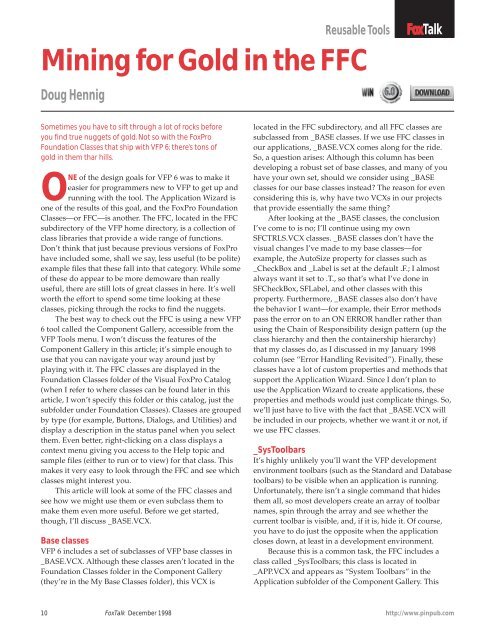Un-Mapping Mapped Network Drives Andrew Coates - dFPUG-Portal
Un-Mapping Mapped Network Drives Andrew Coates - dFPUG-Portal
Un-Mapping Mapped Network Drives Andrew Coates - dFPUG-Portal
Create successful ePaper yourself
Turn your PDF publications into a flip-book with our unique Google optimized e-Paper software.
Mining for Gold in the FFC<br />
Doug Hennig<br />
Sometimes you have to sift through a lot of rocks before<br />
you find true nuggets of gold. Not so with the FoxPro<br />
Foundation Classes that ship with VFP 6; there’s tons of<br />
gold in them thar hills.<br />
ONE of the design goals for VFP 6 was to make it<br />
easier for programmers new to VFP to get up and<br />
running with the tool. The Application Wizard is<br />
one of the results of this goal, and the FoxPro Foundation<br />
Classes—or FFC—is another. The FFC, located in the FFC<br />
subdirectory of the VFP home directory, is a collection of<br />
class libraries that provide a wide range of functions.<br />
Don’t think that just because previous versions of FoxPro<br />
have included some, shall we say, less useful (to be polite)<br />
example files that these fall into that category. While some<br />
of these do appear to be more demoware than really<br />
useful, there are still lots of great classes in here. It’s well<br />
worth the effort to spend some time looking at these<br />
classes, picking through the rocks to find the nuggets.<br />
The best way to check out the FFC is using a new VFP<br />
6 tool called the Component Gallery, accessible from the<br />
VFP Tools menu. I won’t discuss the features of the<br />
Component Gallery in this article; it’s simple enough to<br />
use that you can navigate your way around just by<br />
playing with it. The FFC classes are displayed in the<br />
Foundation Classes folder of the Visual FoxPro Catalog<br />
(when I refer to where classes can be found later in this<br />
article, I won’t specify this folder or this catalog, just the<br />
subfolder under Foundation Classes). Classes are grouped<br />
by type (for example, Buttons, Dialogs, and Utilities) and<br />
display a description in the status panel when you select<br />
them. Even better, right-clicking on a class displays a<br />
context menu giving you access to the Help topic and<br />
sample files (either to run or to view) for that class. This<br />
makes it very easy to look through the FFC and see which<br />
classes might interest you.<br />
This article will look at some of the FFC classes and<br />
see how we might use them or even subclass them to<br />
make them even more useful. Before we get started,<br />
though, I’ll discuss _BASE.VCX.<br />
Base classes<br />
VFP 6 includes a set of subclasses of VFP base classes in<br />
_BASE.VCX. Although these classes aren’t located in the<br />
Foundation Classes folder in the Component Gallery<br />
(they’re in the My Base Classes folder), this VCX is<br />
Reusable Tools FoxTalk<br />
10 FoxTalk December 1998<br />
http://www.pinpub.com<br />
6.0<br />
located in the FFC subdirectory, and all FFC classes are<br />
subclassed from _BASE classes. If we use FFC classes in<br />
our applications, _BASE.VCX comes along for the ride.<br />
So, a question arises: Although this column has been<br />
developing a robust set of base classes, and many of you<br />
have your own set, should we consider using _BASE<br />
classes for our base classes instead? The reason for even<br />
considering this is, why have two VCXs in our projects<br />
that provide essentially the same thing?<br />
After looking at the _BASE classes, the conclusion<br />
I’ve come to is no; I’ll continue using my own<br />
SFCTRLS.VCX classes. _BASE classes don’t have the<br />
visual changes I’ve made to my base classes—for<br />
example, the AutoSize property for classes such as<br />
_CheckBox and _Label is set at the default .F.; I almost<br />
always want it set to .T., so that’s what I’ve done in<br />
SFCheckBox, SFLabel, and other classes with this<br />
property. Furthermore, _BASE classes also don’t have<br />
the behavior I want—for example, their Error methods<br />
pass the error on to an ON ERROR handler rather than<br />
using the Chain of Responsibility design pattern (up the<br />
class hierarchy and then the containership hierarchy)<br />
that my classes do, as I discussed in my January 1998<br />
column (see “Error Handling Revisited”). Finally, these<br />
classes have a lot of custom properties and methods that<br />
support the Application Wizard. Since I don’t plan to<br />
use the Application Wizard to create applications, these<br />
properties and methods would just complicate things. So,<br />
we’ll just have to live with the fact that _BASE.VCX will<br />
be included in our projects, whether we want it or not, if<br />
we use FFC classes.<br />
_SysToolbars<br />
It’s highly unlikely you’ll want the VFP development<br />
environment toolbars (such as the Standard and Database<br />
toolbars) to be visible when an application is running.<br />
<strong>Un</strong>fortunately, there isn’t a single command that hides<br />
them all, so most developers create an array of toolbar<br />
names, spin through the array and see whether the<br />
current toolbar is visible, and, if it is, hide it. Of course,<br />
you have to do just the opposite when the application<br />
closes down, at least in a development environment.<br />
Because this is a common task, the FFC includes a<br />
class called _SysToolbars; this class is located in<br />
_APP.VCX and appears as “System Toolbars” in the<br />
Application subfolder of the Component Gallery. This
















